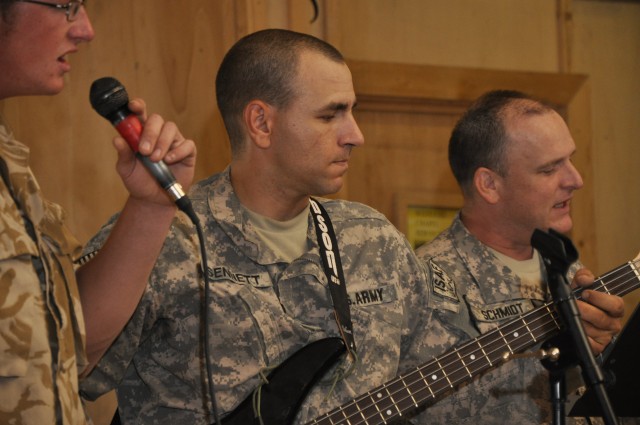KANDAHAR AIRFIELD, Afghanistan Aca,!" The role of the U. S. Army chaplain assistant can be traced back to the American Civil War. Officially, the military occupational specialty now identified as 56M began in 1909 when the Chief of Staff of the Army authorized that each chaplain have one enlisted Soldier assigned to him as an aid. One hundred years later, chaplain assistants still fill a crucial need by supporting their assigned chaplain in a broad range of areas, from secretarial work to physical protection.
Chaplain assistants for the Joint Sustainment Command-Afghanistan, Sgt. Lindsay A. Canterbury and Spc. Joshua A. Sennett, fill a time-honored role in the Army while deployed to Kandahar Airfield.
Aca,!A"Chaplain Assistants do a myriad of things that multiply the time the chaplain has to give to Soldiers,Aca,!A? said Chaplain (Col.) Stanley Puckett, the JSC-A command chaplain.
Canterbury, a reservist from Tampa, Fla. on her second deployment, serves with the 143d Expeditionary Sustainment Command, which leads the JSC-A. She enlisted for a challenge and decided to pursue being a chaplain assistant when an Army recruiter showed her a video of the MOS.
Aca,!A"I saw a weapon, body guard and someone that was able to work with Soldiers on a day to day basis,Aca,!A? said Canterbury. Aca,!A"It sounded like a pretty good job description, and has [proven] to be.Aca,!A?
The seven week training at the U.S. Army Chaplain School and Center at Fort Jackson, S. C., is broken down into five stages: religious support and operations, support in a unit setting, preparing for deployment, support during deployment and support during troop transition stages.
Aca,!A"It is a challenge,Aca,!A? said Canterbury. Aca,!A"But itAca,!a,,cs a very rewarding challenge.Aca,!A?
Sennett, a guardsman from Linneus, Maine, enlisted after 9/11 and was willing to serve in any role. Now on his first deployment, he works for the 286th Combat Support Sustainment Battalion, a JSC-A element.
Aca,!A"In the home environment, a 56M will usually work at the skill level for their rank,Aca,!A? said Canterbury. Aca,!A"In an overseas environment, more is expected of you and just providing religious support is not enough for this MOS.Aca,!A?
Besides providing clerical and administrative support for his chaplain, Sennett regularly supports two to five church services every Sunday. He has even facilitiated services for coalition forces. Sennett counsels troops in emergency situations until the chaplain arrives.
Aca,!A"If someone comes and knocks on the door, I keep him in a calm frame of mind,Aca,!A? said Sennett.
As part of religious support teams, both Canterbury and Sennett travel with chaplains to forward operating bases throughout Southern Afghanistan, where the chaplains hold services and counsel troops who do not receive religious support on a regular basis. Since chaplains do not carry a weapon, Canterbury and Sennett act as bodyguards.
Aca,!A"I try to keep a positive outlook on life, so that it will show as my expression for others to see,Aca,!A? said Canterbury. Aca,!A"ItAca,!a,,cs not so easy to do when you have to go through your own life situations.Aca,!A?
While deployed, Canterbury and the rest of her RST produces, coordinates and executes standard operating procedures for new teams arriving at KAF.
[Canterbury] was very welcoming,Aca,!A? said Chaplain (Maj.) Martine Bellanger, a Canadian pastoral associate. Aca,!A"SheAca,!a,,cs very responsible and wanted to make sure we had everything we needed.Aca,!A?
Canterbury supports a weekly coalition chaplainsAca,!a,,c meeting and Canadian prayer service, and helps provide anything the Canadian RST needs regarding mass. She supplies the coalition team with everything from prayer books to microphones.
Aca,!A"I enjoy working with the opportunity to serve in a multi-faceted role,Aca,!A? said Sennett. Aca,!A"One day IAca,!a,,cll be doing office administration. The second day, IAca,!a,,cll be briefing a command, and the third day in the field with a bunch of infantry guys.Aca,!A?
Sennett and Chaplain (Capt.) Earl Weigelt, personally contribute to the overall mission here by meeting and praying with JSC-A troops before they leave on convoy missions, said Sennett.
Aca,!A"They know we are praying for them while they are on the road traveling,Aca,!A? said Sennett. Aca,!A"I think it gives them a sense of security.Aca,!A?
As RSTs continue to travel throughout Afghanistan providing spiritual and emotional support to troops during Operation Enduring Freedom, Canterbury and Sennett maintain their essential roles in a longstanding, vital MOS.




Social Sharing